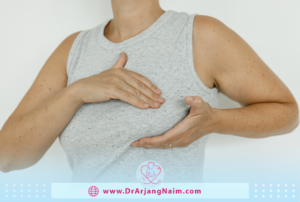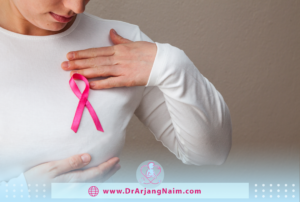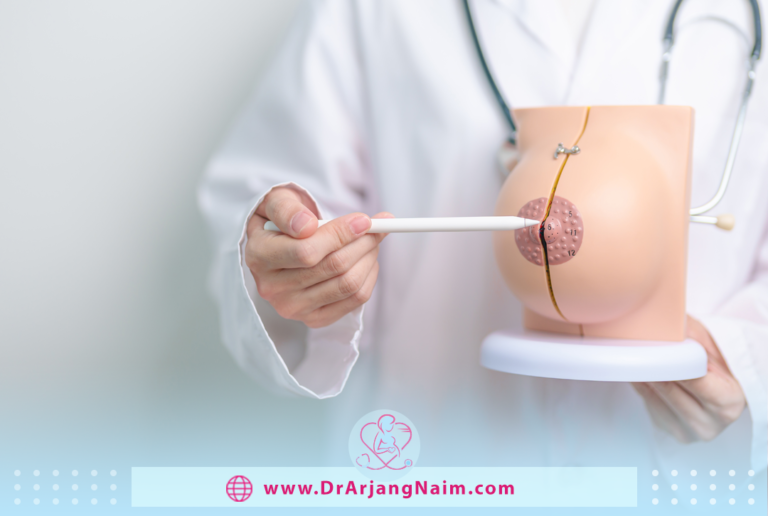The breast anatomy of men and women is slightly different. Breasts are part of the sexual anatomy of both men and women. For women, breasts serve both important functions, such as breastfeeding, and are sexually pleasurable.
The breast is primarily composed of glandular tissue, fibrous tissue, and fatty tissue. Glandular tissue, organized into lobes and lobules, produces milk. Fibrous tissue provides support and structure, while fatty tissue determines the breast’s size and shape. The nipple, a raised area of pigmented skin, is surrounded by the areola, a circular area of darker skin. Cooper’s ligaments, bands of connective tissue, help maintain breast shape. Additionally, the breast contains blood vessels, lymph vessels, and nerves.

What are breasts?
Breasts are part of the sexual anatomy of both men and women. For women and those assigned female at birth, breasts are both functional and sexual. There is no physiological function for men and those assigned male at birth. However, a man’s breasts can still provide sexual pleasure.
The visible parts of the breast anatomy include the nipples and areolae. Most people are born with two breasts, glandular organs located above the chest wall, and pectoral muscles. Breasts are present in both sexes; however, women’s breasts are more developed. Breasts are also an important component of the female reproductive system.
When puberty occurs, female breasts grow more rapidly due to the influence of estrogen and other hormones. These lead to the development of fatty tissue that gives the female breasts a hemispherical shape, glandular tissue, and a duct system.
The structure of the male breast is almost identical to that of the female. However, they usually lack the specialized structures that allow female breasts to produce and secrete milk. In some cases, men may develop a condition called gynecomastia, in which the mammary glands become enlarged and resemble female breasts.

What are the three layers of a woman’s breast?
The three primary layers of a woman’s breast are:
- Glandular Tissue: This tissue is responsible for milk production. It consists of lobes and lobules connected to the nipple through milk ducts.
- Fibrous Tissue: This tissue provides support and structure to the breast. It forms Cooper’s ligaments, which help maintain the breast’s shape.
- Fatty Tissue: This tissue fills the spaces between the glandular and fibrous tissues, determining the breast’s size and shape
What is the anatomy of the breasts?
There are different parts to the anatomy of the female breast, including:
- Adipose tissue: The breast is made up mostly of fatty tissue. It extends from the collarbone to the armpit and across the chest.
- Lobes: Each breast has between 15 and 20 lobes or sections. These lobes surround your nipple like the spokes on a wheel.
- Glandular tissue (lobules): These small tissue sections inside the lobes have tiny bulbous glands at the ends, producing milk.
- Milk ducts (mammary glands): These small tubes or ducts carry milk from the glandular tissue (lobules) to the nipples.
- Nipples: The nipple is located in the center of the areola. Each nipple has about nine milk ducts and hundreds of nerves.
- Areola: The areola is the darker circular skin area surrounding the nipple. The areola has glands called Montgomery glands that secrete a lubricating oil. This oil protects the nipples and skin from wrinkling during breastfeeding.
- Blood vessels circulate blood throughout the breasts, chest, and body.
- Lymphatic vessels: Part of the lymphatic system, these vessels carry lymph, a fluid that helps the immune system fight infection. They connect to lymph nodes found in the armpits, the chest, and elsewhere.
- Lymph nodes: Small organs that help fight infection.
- Nerves: Nipples have hundreds of nerve endings, making them very sensitive to touch.
What is the anatomy of a male breast?
The male breast is composed of similar structures to the female breast, but they are less developed. The primary components include:
- Nipple and Areola: These external structures are present in both sexes.
- Fatty Tissue: This tissue makes up the majority of the breast mass.
- Rudimentary Ducts: These are underdeveloped milk ducts with no capacity for milk production.
- Minimal Glandular Tissue: Unlike female breasts, male breasts have very little glandular tissue.
It’s important to note that while male breasts are typically small and flat, hormonal imbalances can lead to a condition called gynecomastia, where the breast tissue enlarges.
What are the physiological functions of the breast?
The female hormones estrogen, progesterone, and prolactin play critical roles in the development and function of the breast, which is mainly responsible for producing human milk.
Estrogen
Estrogen stretches the milk ducts and helps them develop side branches to carry more milk.
Prolactin
Prolactin stimulates the production of progesterone and prepares the glands for milk production.
Progesterone
Progesterone Increases the number and size of the lobules in preparation for lactation. This hormone also enlarges the blood vessels and breast cells after ovulation.
Oxytocin
Oxytocin, often called the “love hormone,” is a powerful neuropeptide crucial in various physiological and psychological processes. It’s primarily produced in the hypothalamus and released by the posterior pituitary gland. Oxytocin helps secrete breast milk.
What conditions and disorders affect breast anatomy?
Breast cancer is the number one threat to breast health. Approximately 1 in 13 women will receive a diagnosis of breast cancer in their lifetime. Other conditions that affect breast health include:
- Breast lumps
- Breast pain
- Breast rash
- Benign (noncancerous) breast disease
- Breast cysts
- Fibrocystic breast changes
- Mammary duct ectasia
- Mastitis
- Nipple discharge
What are dense breasts?
Dense breasts are breast tissue with more glandular and fibrous tissue than fatty tissue. This type of breast tissue appears white on a mammogram, making detecting abnormalities such as tumors harder.
While dense breasts are not a disease, they can increase your risk of breast cancer and make it harder to detect cancer on a mammogram. If you have dense breasts, your doctor may recommend additional screening tests, such as a breast ultrasound or MRI, to improve cancer detection.

Breast cancer screening
Breast cancer occurs when breast cells grow uncontrollably and rapidly. This can be due to mutations or changes in genes that control the growth of breast cells. Breast cancer can spread to other parts of the body through the blood or lymph.
According to the American Cancer Society, breast cancer is the second leading cause of cancer death in women after lung cancer. Treatment for breast cancer is more likely to be successful if a person can detect the cancer early. People can examine their breasts regularly to increase the chance of early detection.
Both men and women can do similar self-exams to check their breast health. First, they should examine their breasts in a mirror with their shoulders back and their arms at their sides. They should check that their breasts are their usual size, shape, color, and uniformity.
People should look for changes such as:
- Dimpling, puckering, or skin dimpling
- Change in nipple position or if the nipple is turned inward instead of outward
- Redness
- Rash
- Swelling
- Pain
Next, the person should raise both hands and look for similar changes. They should also check if fluid comes from one or both nipples.
The person should then lie down and examine their breasts with their hands. To examine the left breast, the person should use their right hand and vice versa for the right breast.
They should examine the breast using a circular motion, starting at the nipple and moving outward, making sure to reach the collarbone, upper abdomen, and armpit area. The person should apply firm enough pressure to feel for any lumps. Finally, the person should repeat the previous step while standing.
If a person notices any changes, lumps, or discharge from the nipple, they should consult a doctor. Your doctor can order tests to ensure a correct diagnosis.

Strategies for maintaining breast health
Maintaining breast health is essential for overall well-being. Here are some strategies to promote breast health:
- Regular Self-Exams
- Regular Screenings
- Healthy Lifestyle
- Limit Hormonal Exposure
- Reduce Stress
- Breastfeeding
The bottom line
The breast or mammary gland is a part of the sexual organs of both men and women. Also, by simply looking at the structure of the breast, it can be seen that this organ comprises different tissues. In general, the structure of the breast can be divided into two parts. The first structure that can be seen with the naked eye is called the external anatomy of the breast, and then the part that forms the chest that is located inside is called the internal anatomy of the breast.
A woman’s breasts can produce milk for breastfeeding and also act as an erogenous zone. Different types of tissues make up the structure of the breasts. These tissues can become cancerous. Regular mammograms or breast screening can help detect cancer early when it is treatable. Contact your doctor whenever you notice a change in the appearance or tenderness of your breasts.
Additional questions
- What causes gynecomastia?
Changes in the levels of the hormones estrogen and testosterone often cause gynecomastia. But it can also be caused by other things. Gynecomastia can be a side effect of certain medications, such as antidepressants, antibiotics, chemotherapy, prostate cancer drugs, or wound or cardiovascular medications.
- Is it normal to have extra breast tissue?
Breast adipose tissue, leftover breast tissue from fetal development, is found in over 6 percent of the population, most commonly in the armpits along the “milk line.”
- What lifestyle and habits promote breast health?
A sedentary lifestyle is associated with weight gain and an increased risk of breast cancer. Therefore, physical activity should be recommended for women at high risk of breast cancer.
- Which part of the breast is more sensitive?
The nipple contains hundreds of nerve endings. Due to hormones, a woman’s breast is generally more sensitive to stimulation. However, men can also enjoy the nerve endings in their nipples.
- When to worry about breast pain?
While most breast pain is harmless and often related to hormonal changes, it’s important to seek medical attention if you experience persistent or worsening pain, pain localized to a specific area, pain that awakens you from sleep, nipple discharge, visible changes in the breast, or swelling in the underarm.
References
https://www.mskcc.org/cancer-conditions/breast-cancer
https://www.medicalnewstoday.com/articles/breast-anatomy#checking-for-breast-cancer
https://my.clevelandclinic.org/health/articles/8330-breast-anatomy
https://teachmeanatomy.info/thorax/organs/breasts/
https://www.osmosis.org/learn/Anatomy_of_the_breast




